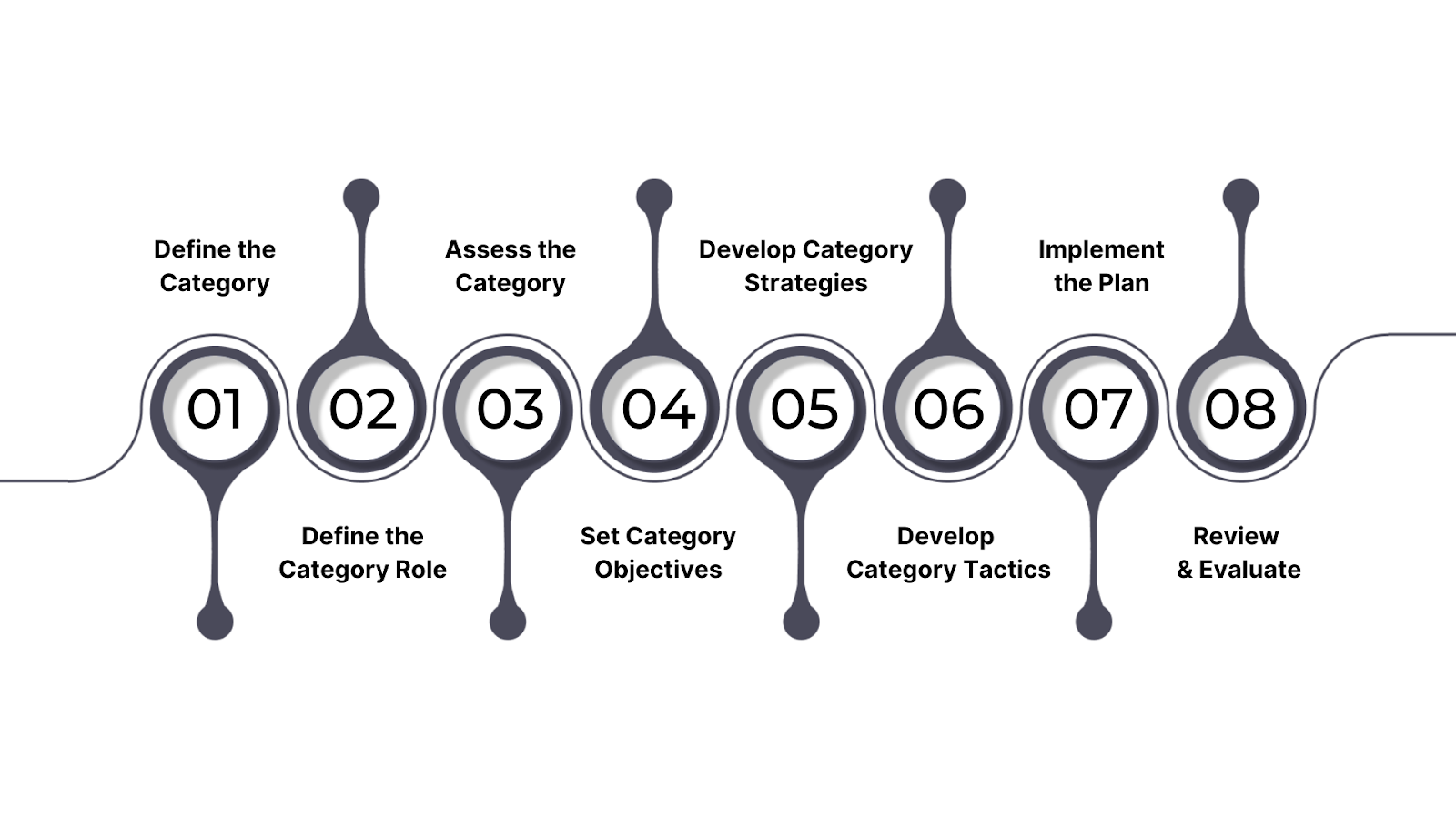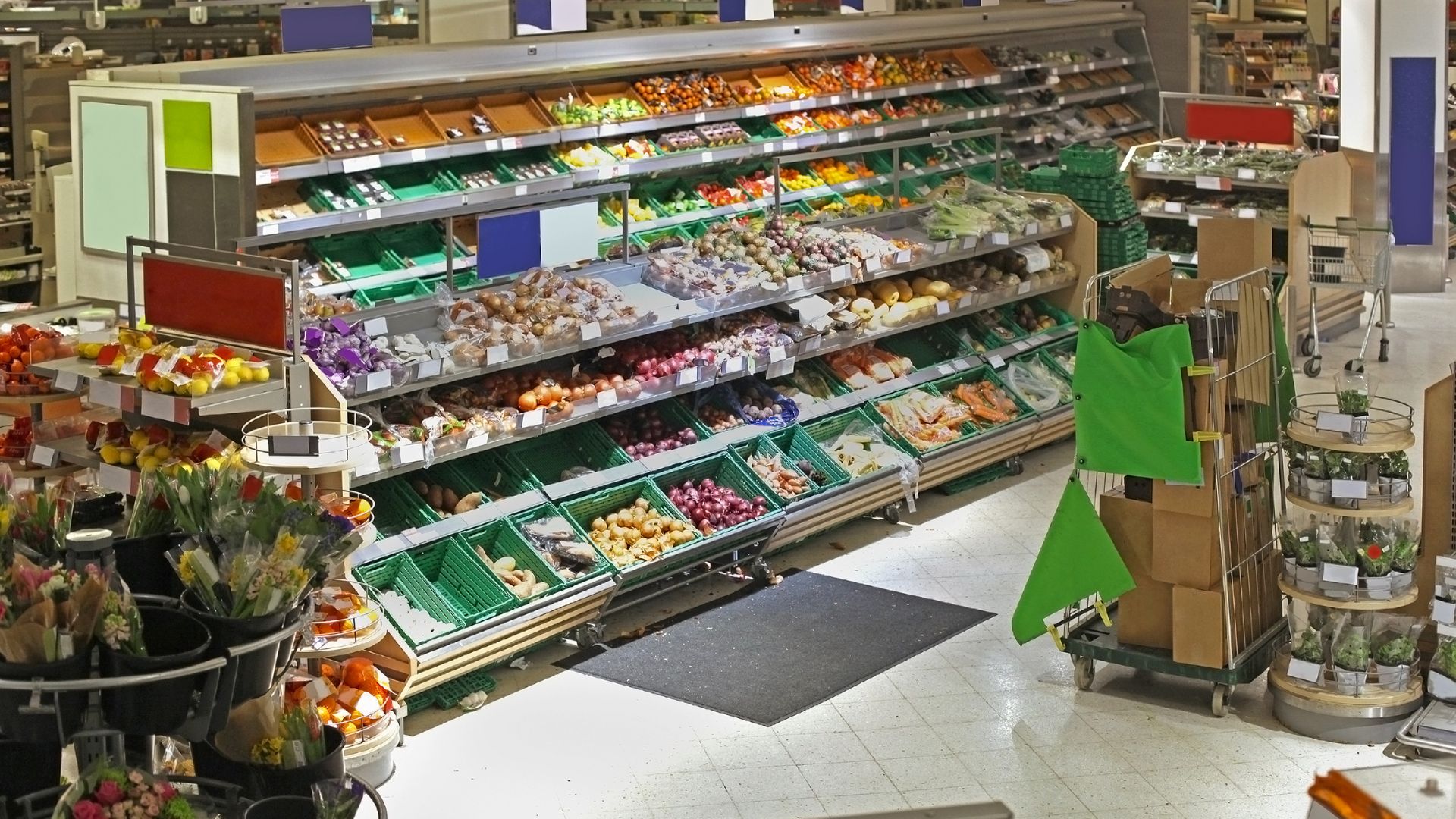For CPG brands, category management is a strategic lever to boost brand visibility, competitive positioning, and execution at the shelf. It’s about how brands can define, track, and grow within a specific category, across multiple retailers and store formats.
Category management in CPG involves optimizing product mix, placement, pricing, and promotions within a category to maximize sales and market share across retailers.
This data-driven approach to retail ensures that your brand can stay ahead in a constantly shifting market. As a CPG brand, ensuring your products stand out and drive sales in a competitive retail environment is more challenging than ever.
In this article, we break down the strategic 8-step category management process every CPG brand should know, along with key strategies to optimize product placement, pricing, and promotions for stronger in-store performance.
Key Takeaways:
- Strategic Category Management Boosts Sales: By aligning category strategies with business objectives and consumer needs, CPG brands can enhance product visibility, optimize product placement, and drive sales both in-store and online.
- Utilize the 8-step framework to optimize category performance: Align product assortment, shelf placement, and promotions with consumer behavior using the structured 8-step process to drive sales and efficiency.
- AI and Data Analytics Drive Informed Decisions: Leveraging real-time data and AI-driven analytics helps brands optimize shelf placement, forecast demand, and track inventory, ensuring products are available when consumers are ready to purchase.
- Effective Shelf Space Utilization Improves Performance: By implementing planograms and analyzing real-time data, CPG brands can maximize shelf space, increase product visibility, and enhance consumer engagement, ultimately improving sales potential.
- Continuous Monitoring and Adjustments Ensure Success: Key performance indicators (KPIs) such as sales volume, on-shelf availability, and consumer engagement help track category management success, allowing brands to adjust strategies and maintain a competitive edge.
What is CPG Category Management?
CPG category management is the process by which CPG brands manage their products within a specific category to enhance their shelf presence, market share, and in-store execution across retailers. It helps CPG teams track performance, ensure planogram compliance, optimize promotions, and stay competitive within their category.
CPG brands and retailers often operate with different objectives and challenges, making it important to understand their roles for optimizing category management strategies. To succeed in category management, CPG brands must analyze consumer behavior, including shopping habits, preferences, and emerging trends, to effectively cater to their needs.
Additionally, staying attuned to market dynamics and competitor activity is essential. Analyzing competitor strategies and identifying market gaps enables CPG brands to adjust their approach and maintain a competitive edge. Tools that provide real-time insights into consumer behavior and market trends enable brands to remain agile and effectively position their products in the retail environment.
Here’s how effective CPG category management can elevate your brand's retail presence:
- Enhance In-Store Visibility: Ensure products are visible where they matter most.
- Use Data Analytics: Make data-backed decisions for better product positioning.
- Drive Consumer Engagement: Use the power of insights to boost consumer loyalty.
Therefore, for CPG brands, it’s about making data-backed decisions that improve execution, drive category growth, and strengthen their role as strategic partners to retailers.
Following a systematic approach, CPG brands gain better control over shelf presence, maximize ROI on trade spend, and ensure that their products meet the right shoppers, in the right place, at the right time.
The 8-Step Category Management Process (A CPG Brand Perspective)

The 8-Step Category Management Process is a method for organizing and explaining the steps that CPG brands follow to manage their product categories in retail environments effectively.
It breaks down the complex process of how brands can plan, execute, and optimize product placement, pricing, promotions, and shelf execution into eight clear, manageable steps. This helps CPG teams understand their role and actions in driving category growth, improving shelf presence, and competing effectively within the category.
Think of it as a roadmap for CPG brands to take control of how their products perform on shelves across different retailers.
- Define the Category
What it means: Identify the group of products, such as snacks, soft drinks, or personal care, that make up your category based on shopper and retailer perspectives.
Why it matters: Clear category definition sets the competitive landscape and shapes shopper perception, guiding where and how your products compete on the shelf.
- Define the Category Role
What it means: Determine the category’s purpose for the retailer, whether it drives foot traffic, supports margins, or is seasonal.
Why it matters: Knowing the category role helps prioritize shelf space, pricing, and promotions that align with retailer goals and shopper demand.
- Assess the Category
What it means: Analyze performance using real-time data combined with ParallelDots’ Shelfwatch, focusing on key KPIs like on-shelf availability (OSA), share of shelf, and planogram compliance.
Why it matters: This reveals gaps in execution that affect product visibility and sales, highlighting areas where your brand can lead category growth.
- Set Category Objectives
What it means: Establish measurable goals tied to your category’s role, such as increasing share of shelf by X%, or improving OSA to reduce out-of-stocks.
Why it matters: Clear objectives ensure focused efforts that drive tangible business results and align with retailer expectations.
- Develop Category Strategies
What it means: Define approaches to meet your objectives, like optimizing SKU assortment, securing premium shelf placement, or planning promotions based on shelf data.
Why it matters: Strategies backed by real-time shelf insights ensure your brand captures shopper attention and maximizes sales opportunities.
- Develop Category Tactics
What it means: Translate strategies into specific actions, running promotions, scheduling shelf resets, or deploying merchandising teams to maintain compliance and OSA.
Why it matters: Well-planned tactics ensure smooth execution at the store level, keeping your products visible and available where they matter most.
- Implement the Plan
What it means: Execute tactics through retailer partnerships and field teams while monitoring shelf compliance and stock levels with AI-powered image recognition.
Why it matters: Strong execution ensures your products stay in place and in stock, preventing lost sales due to poor shelf conditions.
- Review and Evaluate
What it means: Use real-time analytics to measure outcomes, tracking share of shelf, stockouts, and planogram adherence, and identify improvement areas.
Why it matters: Continuous evaluation helps refine your category strategy, demonstrating value to retailers and maintaining a competitive edge.
Reviewing and evaluating your category performance provides the critical insights needed to shape and refine your brand approach. With real-time data on share of shelf, stockouts, and planogram compliance, you can pinpoint what’s working and what needs adjustment. Here’s how to develop a category strategy that drives sales.
How to Develop a Category Strategy?
Effective category management begins with aligning your strategies with business objectives and consumer needs. Here’s how you can create a category strategy that maximizes product visibility and sales:
- Aligning with Business Objectives
Your category strategy should directly support your business goals. Whether your objective is to increase market share, enter new markets, or improve profitability, your strategy should be built around these outcomes. This alignment ensures that your product assortment, pricing, and promotions all work together to drive the desired results.
- Building a Consumer-Centric Strategy
The foundation of any category management strategy should be the consumer. Understanding consumer preferences, their purchasing behavior, and motivations will help you customize your offerings and placement. By focusing on consumer-centric strategies, you can create a more personalized shopping experience that enhances brand loyalty and drives sales.
- Using Data Analytics for Strategic Insights
Data analytics empowers CPG brands to make informed, data-driven decisions. By using insights from sales data, consumer behavior, and market trends, brands can pinpoint which products are performing well, which are underperforming, and identify opportunities to optimize product placement or promotions.
Also Read: How Category Managers Can Champion Category Growth and Help Drive Incremental Sales
What are the Key Strategies For CPG Category Management?
CPG brands must be strategic in their approach to product placement and optimization. Below are the essential strategies that can help you stand out on the shelf and boost your in-store performance.
- Category Segmentation and Targeting
Segmenting your products based on consumer needs ensures that your offerings align with what customers are looking for. By targeting the right audience and identifying key segments, you can better position your products and create marketing campaigns that speak directly to the needs of your consumers.
- Product Assortment and Portfolio Management
A balanced and well-managed product assortment is key to ensuring your brand remains competitive. Monitoring product performance, managing product introductions, and phasing out underperforming products will help maintain a dynamic and relevant portfolio. By managing product lifecycles and introducing new products strategically, you can ensure that your portfolio aligns with consumer demand.
- Optimizing Inventory Levels
Effective inventory management ensures that you don’t overstock or understock products. By using demand forecasting and data analytics, you can ensure that you have the right amount of stock in-store, avoiding both stockouts and excess inventory.
Also Read: How is AI helping CPGs Optimize their Assortment Strategy
- Pricing Strategies
Setting the right price is essential for driving sales and ensuring competitiveness in the market. Understanding the competitive market and pricing models is important for you to stay ahead. By offering dynamic pricing that aligns with consumer expectations and market standards, brands can increase the chances of capturing market share. Brands can implement pricing strategies that maximize revenue and profitability by using AI and real-time data.
- Promotional Strategy and Execution
Effective promotional strategies can drive both short-term sales and long-term customer loyalty. Promotions should be strategically planned to align with both seasonal trends and consumer demand. Offering discounts, bundle deals, or seasonal promotions can drive foot traffic and increase sales during key periods.
It’s essential to track the success of promotional campaigns. By analyzing real-time data and consumer feedback, CPG brands can refine future campaigns and ensure that promotions deliver maximum impact.
- Shelf Space Optimization
Shelf space is a valuable resource in retail, and optimizing its use is essential for improving product visibility and driving sales. By analyzing real-time data, CPG brands can determine the amount of space allocated to each product and assess its effectiveness.
Products placed in high-traffic areas typically see higher engagement and sales, making it crucial to utilize this space wisely. Implementing effective planograms ensures that products are organized in a way that maximizes space while making them easy to find and access, thereby enhancing visibility and consumer interaction.
Using advanced tools like AI and machine learning enables brands to make data-driven decisions, optimizing shelf placement. This ensures that products are always positioned for maximum impact, ultimately boosting sales potential and in-store performance.
- Key Performance Indicators for CPG Categories
Key performance indicators (KPIs) such as on-shelf availability, sales volume, and consumer engagement are essential for measuring the success of category management efforts.
These metrics provide valuable insights into which strategies are delivering results and where adjustments may be necessary. Retail analytics tools enable brands to track product performance in real-time, offering data on sales, inventory levels, and consumer behavior. This real-time data is crucial for refining strategies and maintaining optimal in-store performance.
Ultimately, continuous improvement should be the core focus of any category management strategy, as regularly analyzing performance data and making informed adjustments ensures that brands stay ahead of the competition and can effectively meet the ever-evolving demands of consumers.
How Can ParallelDots Help CPG Brands with Category Management?
ParallelDots offers AI-driven solutions that help CPG brands optimize their on-shelf monitoring and in-store execution. Using real-time data and predictive analytics, ParallelDots empowers brands to enhance their retail execution and improve the overall customer experience by ensuring that products are optimally placed and always available for purchase.
- Real-Time Shelf Monitoring: Track the availability, placement, and stock levels of your products across multiple retail locations, ensuring that products are placed in high-traffic areas for maximum exposure.
- Automated Image Recognition with ODIN: This deep learning tool provides real-time SKU-level product recognition, helping brands ensure compliance with planograms and maximizing shelf space and visibility.
- Planogram Compliance Monitoring: Automated tools ensure your products are positioned according to predefined planograms, which optimize shelf space and increase on-shelf visibility.
- Pricing Compliance Verification: ParallelDots uses Optical Character Recognition (OCR) technology to ensure price tags are displayed correctly, reducing pricing errors and improving consumer trust.
Conclusion
Effective category management isn’t just about shelf presence; it’s about aligning data insights with strategic execution. Brands that consistently get this right not only boost sales but also become preferred partners for retailers by ensuring consistency, compliance, and shopper impact at scale.
If you’re looking to strengthen your category strategy or evaluate your current approach, now is the time. Tools like ParallelDots’ ShelfWatch provide the real-time visibility and analytics needed to make smarter, faster decisions at the shelf.
Schedule a demo with ParallelDots today to learn how our AI-powered solutions can help optimize your on-shelf performance and improve your in-store execution.
FAQs
- What is CPG category management?
CPG category management involves optimizing product placement, pricing, and promotions to maximize product visibility and sales. It focuses on understanding consumer behavior and using data-driven strategies to enhance in-store performance. - How can AI help with product placement in retail?
AI helps CPG brands optimize product placement by analyzing consumer data in real-time. It allows brands to predict demand, ensure products are in high-traffic areas, and manage inventory more efficiently. - What are the key benefits of planogram compliance?
Planogram compliance ensures that products are positioned according to a predetermined layout, which maximizes shelf space, improves visibility, and boosts consumer engagement and sales. - How can CPG brands optimize their inventory levels?
By using data analytics and predictive insights, CPG brands can ensure they maintain optimal inventory levels, preventing both stockouts and excess inventory, which can impact product availability and sales.
What are the challenges in the CPG category management?
Challenges include competition for shelf space, data overload, and the difficulty of adapting quickly to changing consumer preferences. Leveraging advanced technology and real-time data can help overcome these challenges.


